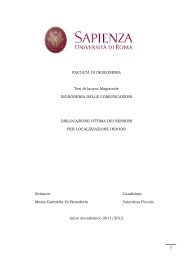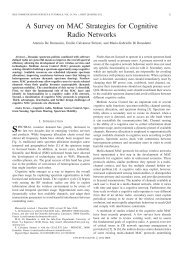Tecniche acustiche di inversione temporale e DOA con applicazione ...
Tecniche acustiche di inversione temporale e DOA con applicazione ...
Tecniche acustiche di inversione temporale e DOA con applicazione ...
You also want an ePaper? Increase the reach of your titles
YUMPU automatically turns print PDFs into web optimized ePapers that Google loves.
2. Stima della <strong>di</strong>rezione d’arrivo <strong>DOA</strong> 31<br />
pseudospettro MUSIC (dB)<br />
35<br />
30<br />
25<br />
20<br />
15<br />
10<br />
5<br />
0<br />
−5<br />
metodo MUSIC<br />
−10<br />
−100 −80 −60 −40 −20 0 20 40 60 80 100<br />
angoli <strong>di</strong> incidenza in gra<strong>di</strong><br />
Figura 2.2: algoritmo MUSIC-trasmisione <strong>di</strong> due segnali ortogonali che sono<br />
ricevuti a [10 ◦ ,30 ◦ ], SNR [10 10]dB, 500 campioni<br />
La (2.12) è la matrice <strong>di</strong> covarianza campionata, se i camponi misurati appar-<br />
tengono ad una <strong>di</strong>stribuzione gaussiana questa stima <strong>con</strong>verge asintoticamente<br />
alla matrice <strong>di</strong> covarianza reale. Nella simulazione svolta in ambito della tesi<br />
è stato implementato, <strong>con</strong> l’ausilio <strong>di</strong> MATLAB, il MUSIC <strong>con</strong>siderando la<br />
trasmissione <strong>di</strong> due segnali sinuosoidali alla frequenza <strong>di</strong> 3 GHz. Le sinusoi<strong>di</strong><br />
hanno entrambe potenza pari a 0 dBW e i loro fronti d’onda scorrelati giun-<br />
gono rispettivamente <strong>con</strong> angoli <strong>di</strong> 10 ◦ e30 ◦ rispetto all’array <strong>di</strong> sensori. Sul






